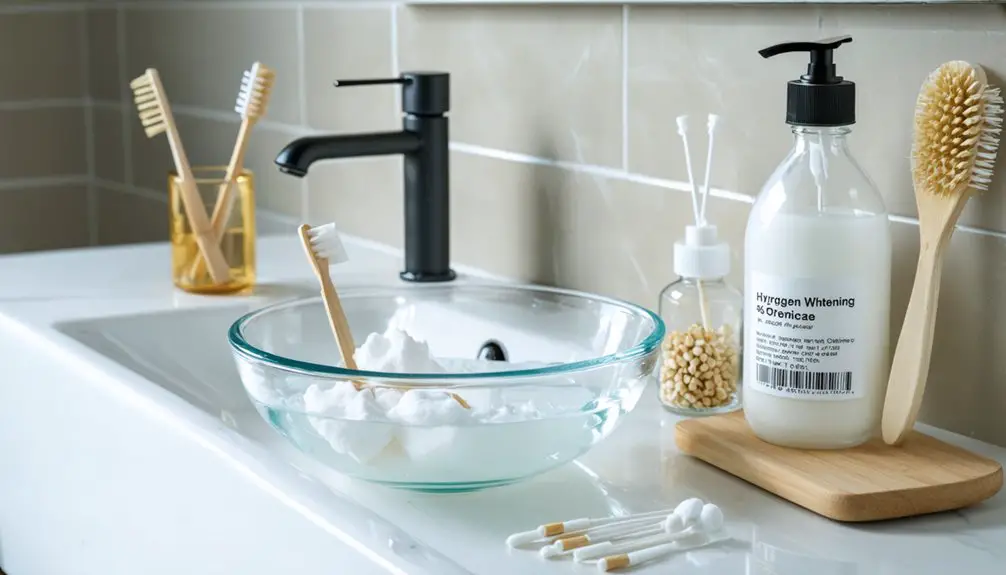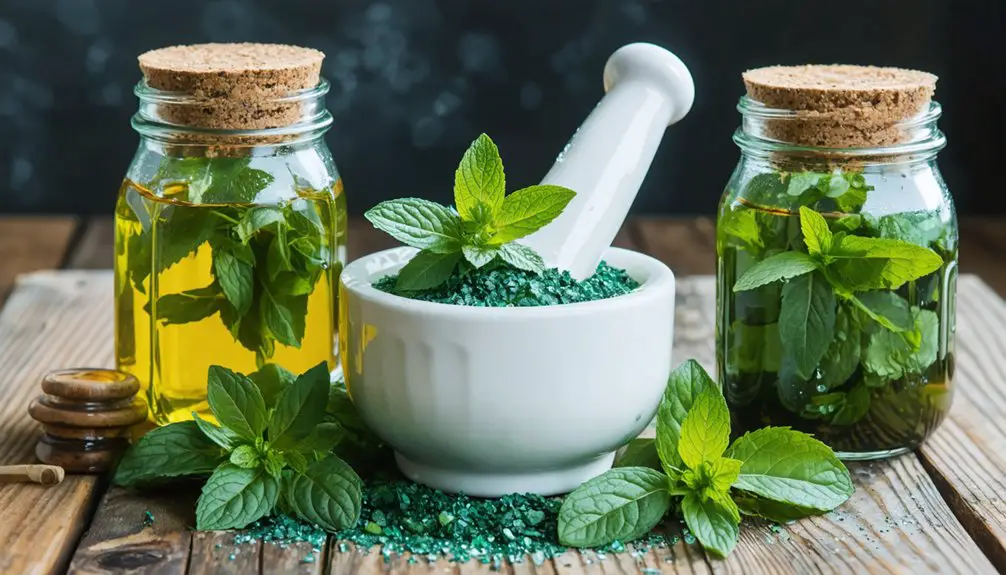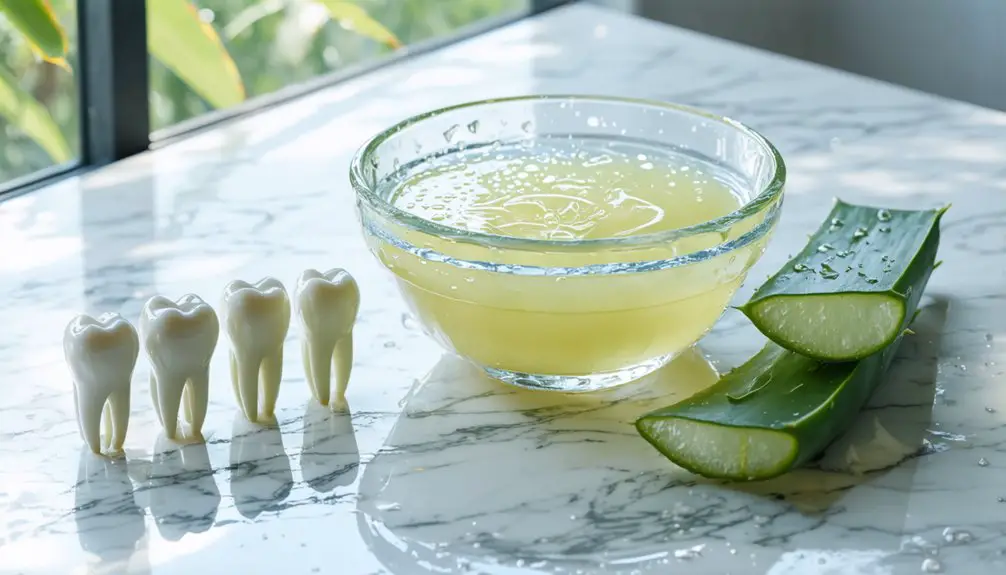You’ll find hydrogen peroxide teeth whitening options ranging from professional to at-home treatments. Professional in-office procedures use 35-38% concentrations with LED activation, while custom-fitted take-home trays offer controlled application. Over-the-counter strips, whitening gels, specialized toothpaste, and mouthwash solutions provide varying strengths of 1-20%. Two-step kits, combination methods, and natural remedies enhanced with peroxide round out your choices. Let’s explore each method’s specific benefits and protocols.
Key Takeaways
- Professional in-office treatments using 35-38% hydrogen peroxide gel with LED activation provide the most dramatic results in a single session.
- Custom-fitted take-home trays with professional-grade gel offer controlled whitening while minimizing sensitivity and gum irritation.
- Over-the-counter whitening strips containing 3-10% hydrogen peroxide provide affordable, gradual results with daily 30-minute applications.
- Light-activated systems combining blue LED with 12-44% hydrogen peroxide can improve tooth shade by up to 4.8 levels.
- Mixing baking soda with hydrogen peroxide creates a gentle whitening paste suitable for twice-weekly application.
Professional In-Office Whitening Treatments
When seeking professional teeth whitening, in-office treatments offer the most potent and controlled approach under direct dental supervision.
Your dentist will begin with a thorough examination, removing tartar and filling cavities to enhance whitening efficacy. They’ll then apply protective barriers to shield your gums, lips, and soft tissues from the high-concentration hydrogen peroxide gel.
The treatment involves precise application of 35-38% hydrogen peroxide gel activated by LED, UV, or laser light. The natural bleaching properties of hydrogen peroxide help break down stubborn stain compounds deep within the teeth. A shade guide is used to document and track the whitening progress during treatment. You’ll undergo 3-4 rounds of 15-minute light activation sessions, with careful monitoring throughout the process.
In-office safety measures include protective eyewear and rubber dams to guarantee superior results while minimizing sensitivity. This professional approach can brighten your teeth by 6-8 shades in a single session, with results lasting up to a year with proper maintenance.
Custom-Fitted Take-Home Whitening Trays
While in-office treatments deliver rapid results, custom-fitted take-home whitening trays offer a professional-grade alternative that combines comfort, effectiveness, and convenience. Under dentist supervision, you can ensure safe and optimal whitening results throughout your treatment process.
Custom tray benefits include precise dental impressions that mold exactly to your teeth, guaranteeing ideal whitening gel consistency and distribution. The high-quality ingredients help maintain optimal safety for your teeth and gums during treatment. You’ll experience reduced sensitivity and gum irritation compared to generic options, while achieving uniform results even on uneven or crooked teeth.
- Professional-grade whitening gel provides significant shade improvement with controlled application
- Precise fit prevents gel leakage and guarantees even coverage of all tooth surfaces
- Flexible treatment schedule allows 4-hour daily or overnight wear based on your lifestyle
- Reusable trays enable periodic touch-ups while maintaining long-term results with proper maintenance
Over-the-Counter Whitening Strips
To achieve ideal whitening results, you’ll need to firmly press each strip onto your teeth’s surface for the manufacturer’s recommended duration, typically 30 minutes daily for 10-14 days. Strips use advanced seal technology to maintain consistent contact between whitening agents and teeth.
While over-the-counter strips contain 3-10% hydrogen peroxide and can lighten teeth 1-2 shades, professional treatments utilize concentrations of 25-35% for more dramatic results. Regular touch-ups are needed since results are temporary.
If you’re seeking maintenance or mild whitening, strips offer an effective and affordable option, but significant color corrections will require professional-strength treatments.
Application Tips and Timing
Proper application of whitening strips begins with thorough preparation of your teeth. Brush and floss to remove debris, then make certain your teeth are completely dry to maximize strip adhesion. Budget-friendly options typically cost between $30-50 for a complete treatment course.
When applying, focus on proper strip alignment along your gum line without covering the gums themselves. The application frequency varies by brand, typically ranging from once daily for two weeks to twice daily for three weeks. The oxidation process breaks down both surface and deep stains as the peroxide penetrates your enamel.
- Press firmly on each strip and smooth out air bubbles to guarantee complete contact with tooth surfaces
- Leave strips in place for exactly 30 minutes – no longer to protect your enamel
- Remove strips gently after the recommended time and dispose immediately
- If sensitivity occurs, use fluoride toothpaste designed for sensitive teeth
Remember to store unopened strips in a cool, dry place and only open packages right before use to maintain peroxide potency.
Effectiveness Vs Professional Treatment
Although both professional and over-the-counter whitening treatments rely on hydrogen peroxide as their primary active ingredient, their effectiveness differs markedly due to concentration levels and application methods.
Professional treatments use 25-40% hydrogen peroxide concentrations for rapid results in 30-60 minute sessions, while OTC strips contain only 6-10%, requiring longer treatment periods for visible effects. Consulting a dental professional first can help determine the safest concentration for your teeth sensitivity level.
When considering whitening effectiveness, you’ll achieve faster, more dramatic results with professional treatments, particularly those using light activation. Most dentists report an 79% success rate with vital tooth bleaching treatments.
However, OTC strips can still effectively remove artificial stains and lighten natural enamel color with consistent use.
While both methods share common safety concerns like tooth sensitivity (44-59% of users), professional treatments offer supervised conditions for managing side effects.
You’ll need to weigh the trade-off between immediate results and extended treatment time when choosing between these options.
Hydrogen Peroxide Gel Applications
Your dentist can apply high-concentration hydrogen peroxide gels (25-43%) in-office using custom-fitted trays for rapid whitening results.
At home, you’ll use lower-concentration gels (3-20%) with custom trays for 30-minute sessions, typically two to three times daily over one to two weeks.
While professional applications offer immediate results, at-home techniques provide effective whitening with reduced sensitivity risks and greater cost-effectiveness.
Professional Application Methods
When seeking professional teeth whitening treatment, dental practitioners employ highly concentrated hydrogen peroxide gels ranging from 25% to 44% strength – considerably more potent than over-the-counter options.
These professional techniques require careful application protocols and treatment customization based on your specific needs and sensitivity levels.
- Your teeth will be thoroughly cleaned and dried before gel application to guarantee maximum effectiveness.
- A protective barrier or gum dam will be applied to safeguard your soft tissues.
- The gel is precisely applied in thin, even layers using dual-barrel syringes for best results.
- LED or laser light activation may be used to accelerate the whitening process.
Your dentist will monitor the procedure closely, typically lasting 15-30 minutes per session, while assuring proper isolation techniques and safety measures are maintained throughout the treatment.
At-Home Gel Techniques
Safe and effective at-home teeth whitening starts with selecting the right hydrogen peroxide gel concentration, typically ranging from 3% to 20%. For ideal sensitivity management, you’ll want to begin with lower concentrations around 3-3.5%, which align with ADA safety recommendations and minimize risks while delivering gradual whitening effects.
To apply the gel correctly, you’ll need custom-fitted trays that guarantee even distribution across your teeth. Use these for 30-minute sessions multiple times daily, maintaining consistent application over a 1-2 week period.
You’ll notice gel concentration effects vary – higher percentages work faster but may increase tooth sensitivity and gum irritation. Track your progress using a shade guide, as even 3% concentrations can improve tooth color by four shade tabs within two weeks of proper use.
Whitening Toothpaste With Hydrogen Peroxide
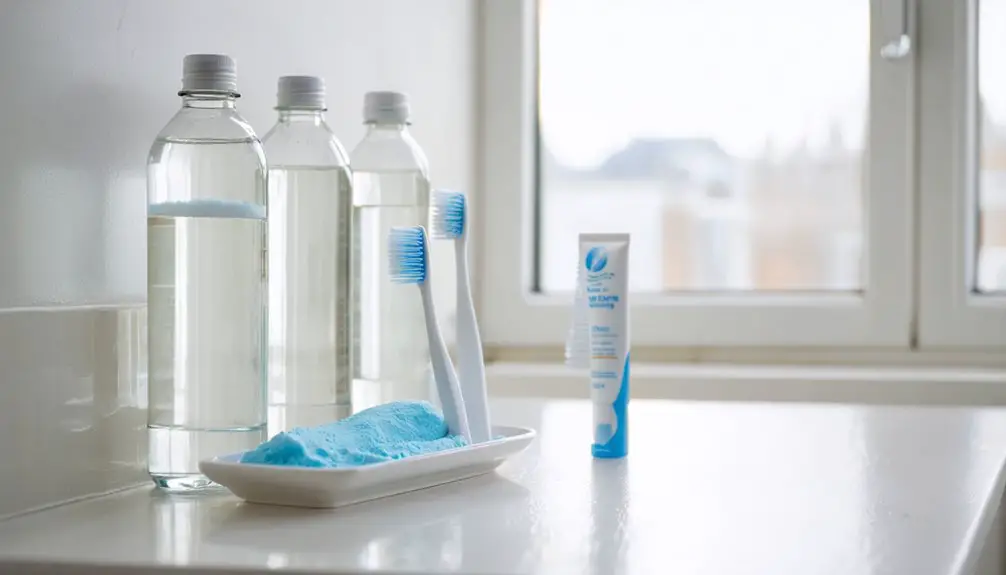
How does hydrogen peroxide in whitening toothpaste work to brighten your smile? Most whitening toothpastes contain around 1.0% hydrogen peroxide, which effectively removes surface stains while maintaining safety.
Hydrogen peroxide’s gentle whitening action helps lift surface stains from teeth while keeping enamel safe at concentrations around 1% in toothpaste.
You’ll notice significant color improvements within 5 days to 8 weeks of consistent use, particularly targeting extrinsic stains. For ideal whitening effectiveness and safety, brush for 2 minutes per session and rinse thoroughly afterward.
- Use as directed to avoid potential enamel erosion or tooth sensitivity from overexposure
- Expect gradual improvements with daily use rather than immediate results
- Monitor your dental health through regular checkups while using whitening products
- Choose ADA-endorsed products containing hydrogen peroxide concentrations below 3.5% for safe at-home use
Light-Activated Hydrogen Peroxide Systems
Light-activated hydrogen peroxide systems represent a modern advancement in teeth whitening technology, combining chemical bleaching agents with specific light wavelengths to accelerate the whitening process.
Blue LED lights offer the highest safety profile while effectively activating peroxide concentrations ranging from 12% in at-home kits to 44% in professional settings.
While LED effectiveness shows promising results with up to 4.8 shade improvements, you’ll need to evaluate sensitivity management, as up to 53% of patients report temporary tooth sensitivity.
Treatment protocols typically involve gingival barriers and careful monitoring, especially with higher peroxide concentrations.
You’ll find that while light activation may speed up the process, it doesn’t necessarily improve whitening longevity.
Safety concerns are minimal with proper protocol adherence, though professional supervision is recommended for high-concentration treatments.
Hydrogen Peroxide Mouthwash Solutions
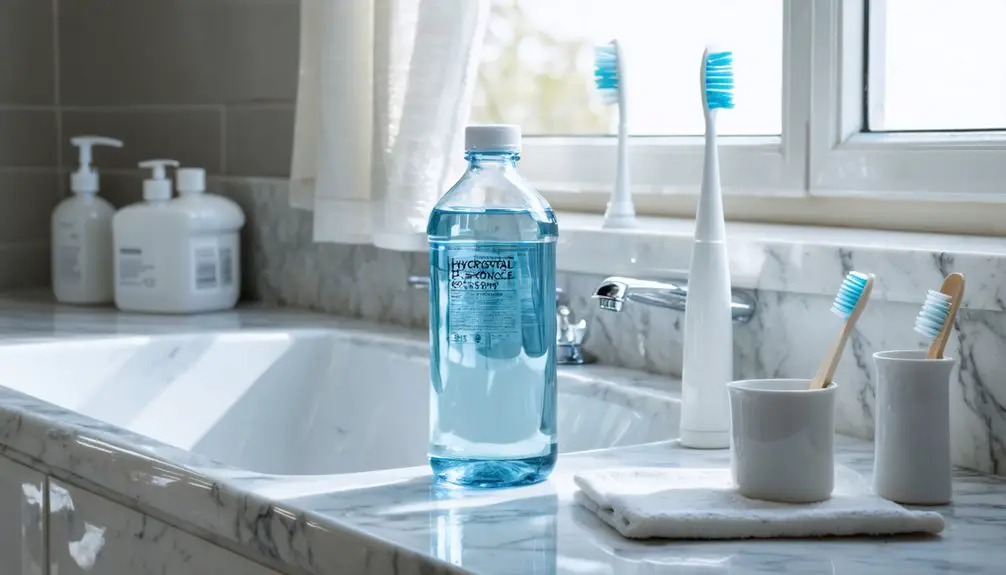
To safely use hydrogen peroxide mouthwash solutions, you’ll need to dilute 3% hydrogen peroxide with water in a 1:1 ratio and swish the mixture for 30-60 seconds before spitting it out completely.
You should limit your whitening rinses to 2-3 times per week and always follow manufacturer guidelines to prevent enamel damage or tissue irritation.
For ideal long-term results, you’ll want to maintain good oral hygiene practices and consider periodic touch-up treatments as stains naturally reaccumulate over time.
Safe Mixing Guidelines
When preparing hydrogen peroxide mouthwash solutions for teeth whitening, precise dilution and measurement are essential for both safety and effectiveness. Follow recommended dilution ratios and safety precautions to guarantee ideal results while protecting your oral health. For home use, mix 1 part 3% hydrogen peroxide with 1-2 parts water, depending on your sensitivity level.
- Always prepare fresh solutions before each use, as diluted hydrogen peroxide loses effectiveness over time.
- Never mix hydrogen peroxide with baking soda or other chemicals unless specifically directed by your dental professional.
- Use accurate measuring tools to achieve proper concentration levels between 1.5-3% for safe oral application.
- Store unmixed hydrogen peroxide in its original container in a cool, dark place to maintain stability and potency.
Application Tips and Timing
Proper application technique directly impacts the effectiveness of hydrogen peroxide mouthwash solutions for teeth whitening.
You’ll need to mix equal parts of 3% hydrogen peroxide with water, ensuring precise measurements to prevent tissue damage. For best results, maintain a swishing duration of 30 seconds to 1 minute, using gentle, controlled movements throughout your mouth.
Limit your application frequency to once or twice daily to protect your enamel and gums. After swishing, spit out the solution completely and rinse with water. Don’t eat, drink, or smoke immediately afterward to maximize the whitening benefits.
If you experience sensitivity or irritation, reduce your usage time or discontinue use. For consistent results, you’ll need to maintain this routine for several days to weeks, as whitening occurs gradually.
Maintaining Results Long-Term
Maintaining long-term whitening results requires a strategic balance between effective hydrogen peroxide use and protective oral care measures. To prevent oral hygiene issues while preserving your whitening outcomes, you’ll need to carefully manage peroxide exposure in your maintenance routine.
Use low-concentration peroxide mouthwash (1-3%) no more than once daily, limiting contact time to 60 seconds to minimize long term effects on enamel and soft tissues.
- Rotate between peroxide and non-peroxide mouthwashes to reduce cumulative exposure while maintaining results
- Follow each peroxide rinse with thorough water rinsing or fluoride treatment
- Monitor for sensitivity and gum irritation, adjusting frequency if needed
- Schedule regular dental checkups to assess oral health and optimize your whitening maintenance plan
Two-Step Whitening Kits

Two-step whitening kits harness the powerful oxidizing properties of hydrogen peroxide to effectively remove both surface and deep-set tooth stains.
The two-step efficacy involves first applying a concentrated H₂O₂ solution, followed by an activating agent that enhances the whitening process. You’ll typically see significant color improvements over 1-3 weeks of daily 30-minute treatments.
While ensuring enamel safety, these kits use controlled concentrations below 3.5% for over-the-counter products.
You’ll need to follow the application protocols carefully to avoid sensitivity and protect your gum tissue. The sequential treatment design allows for gradual whitening, reducing the risk of enamel stress.
For best results, maintain consistent daily use as directed, but remember that results won’t affect existing dental restorations like crowns or veneers.
Combination Whitening Methods
Beyond single-method approaches, combination whitening techniques offer enhanced results through synergistic effects of multiple peroxide-based treatments.
You’ll achieve peak whitening effectiveness by strategically pairing different peroxide-based methods that complement each other.
Professional-grade whitening strips combined with peroxide rinses can maximize stain removal, while baking soda-peroxide paste followed by fluoride products helps protect your enamel during the whitening process.
- Pair ADA-approved whitening strips with low-concentration peroxide rinses for enhanced stain removal
- Combine professional in-office treatments with at-home maintenance using peroxide mouthwash
- Use whitening toothpaste with peroxide rinses to reinforce daily brightening effects
- Apply baking soda-peroxide paste followed by fluoride products to balance whitening with enamel protection
Natural Remedies Enhanced With Hydrogen Peroxide
While professional treatments remain the gold standard for teeth whitening, natural remedies enhanced with hydrogen peroxide offer a gentler, cost-effective alternative for maintaining dental brightness at home.
You’ll find success combining a paste of baking soda and hydrogen peroxide, using one tablespoon of baking soda to two tablespoons of peroxide. Apply this mixture gently for two minutes, no more than twice weekly.
For additional whitening effects, you can complement your routine with a diluted hydrogen peroxide rinse, mixing equal parts 3% peroxide and water.
While some suggest using fruit peel applications, be cautious as their acidic nature risks enamel erosion. Always rinse thoroughly after any whitening treatment, and avoid swallowing solutions to prevent irritation.
Monitor your teeth’s sensitivity and discontinue use if discomfort occurs.
Frequently Asked Questions
Can Hydrogen Peroxide Whitening Damage Existing Dental Work Like Crowns or Veneers?
Properly practiced peroxide whitening won’t damage your dental work. Your crowns and veneers stay secure, though you’ll see minimal surface changes. For safety, stick to concentrations below 6% hydrogen peroxide.
How Long Should I Wait After Teeth Cleaning Before Starting Whitening Treatment?
You’ll want to wait 3-5 days after your teeth cleaning before starting whitening treatment, especially if you’re experiencing sensitivity. This timeline allows your gums and teeth to recover properly.
Does Drinking Through a Straw Prevent Staining While Using Whitening Treatments?
While straw benefits include reducing contact with staining beverages, you’ll still need thorough staining prevention during whitening treatment. Using a straw can help but won’t guarantee complete protection for your results.
Can Teenagers Safely Use Hydrogen Peroxide Whitening Products?
You shouldn’t use hydrogen peroxide whitening until you’re at least 14-16 years old, following safety guidelines and age restrictions. Consult your dentist first, as teen teeth are more vulnerable to damage.
Will Hydrogen Peroxide Whitening Affect the Strength of Dental Bonding Materials?
Yes, hydrogen peroxide will weaken your dental bonding materials. Higher peroxide concentrations greatly reduce bonding longevity, with effects lasting up to 30 days. You’ll need professional guidance to protect your dental work.
References
- https://www.kingwooddentistry.com/post/does-hydrogen-peroxide-whiten-teeth/
- https://pmc.ncbi.nlm.nih.gov/articles/PMC9915942/
- https://www.mountairyfamilydentistry.com/blog/does-hydrogen-peroxide-whiten-teeth
- https://www.hicksdentalgroup.com/whiten-teeth-with-hydrogen-peroxide/
- https://www.gentledental.com/resources/articles/hydrogen-peroxide-teeth-whitening
- https://dwdentistkellyville.com.au/hydrogen-peroxide-teeth-whitening/
- https://www.sundancesmiles.com/blog/all-about-professional-teeth-whitening/
- https://www.medparkhospital.com/en-US/disease-and-treatment/teeth-whitening-treatment
- https://www.toothcafeky.com/post/how-does-professional-teeth-whitening-work
- https://vdcak.com/blog/cosmetic-dentistry/custom-whitening-trays/
